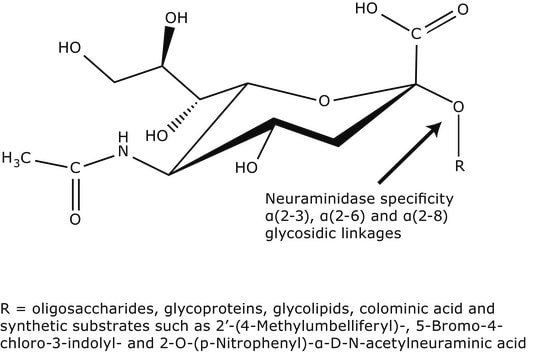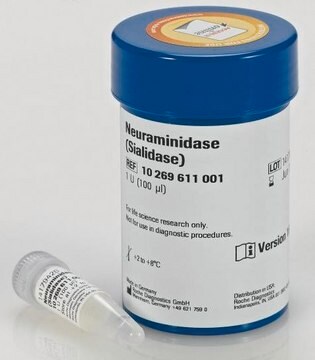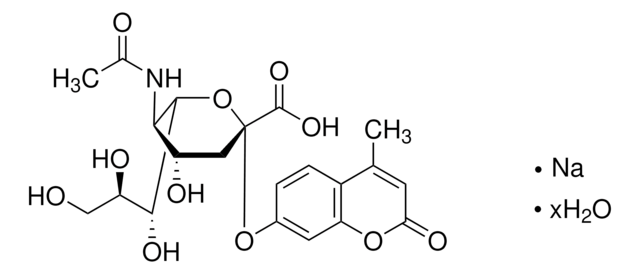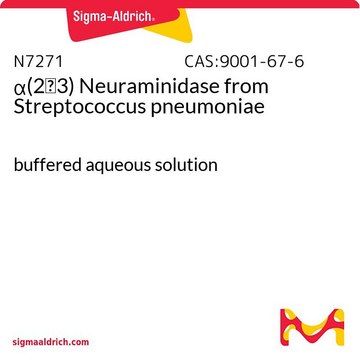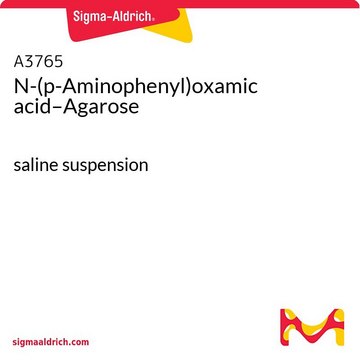N2876
Neuraminidase from Clostridium perfringens (C. welchii)
Suitable for manufacturing of diagnostic kits and reagents, Type V, lyophilized powder
Synonym(s):
Acyl-neuraminyl Hydrolase, Receptor-destroying enzyme, Sialidase
Sign Into View Organizational & Contract Pricing
All Photos(5)
About This Item
Recommended Products
Quality Level
type
Type V
form
lyophilized powder
specific activity
≥0.1 units/mg solid (using mucin)
≥1.3 units/mg solid (using 4MU-NANA)
application(s)
diagnostic assay manufacturing
foreign activity
Protease and NAN-aldolase, present
shipped in
dry ice
storage temp.
−20°C
Gene Information
Clostridium perfringens str. 13 ... nanI(988807)
Looking for similar products? Visit Product Comparison Guide
General description
Neuraminidase enzymes are hydrolase enzymes that promote influenza virus release from infected cells and facilitate virus spread.
Application
Neuraminidase from Clostridium perfringens has been used in a study to assess binding with human T lymphocytes in sheep pretreated with neuraminidase. It has also been used in a study to investigate the effect of bile salts on the action of hydrolysis by neuraminidase.
Biochem/physiol Actions
Neuraminidase can increase aggregation in certain cell lines by removing exposed negatively charged sialic acid residues on the cell surface.
Neuraminidase cleavage of sialic acid groups has been used to study recognition by antibodies of glycoprotein structures. The use of neuraminidase in the estimation of N-acetylneuraminic acid was compared favorably to two other methods.
Neuraminidases are used to cleave terminal N-acetyl neuraminic acid (sialic acid) from a variety of glycoproteins. The enzyme from Clostridium perfringens cleaves terminal sialic acid residues which are α-2,3- α-2,6- or α-2,8-linked to Gal, GlcNac, GalNAc, AcNeu, GlcNeu, oligosaccharides, glycolipids or glycoproteins. The relative rate of cleavage decreases in the order: α-2-3 > α-2-6 . α-2-8. Neuraminidase from C. perfringens cleaves α-2-3 linked sialic acid residues most efficiently, compared to A. ureafaciens, (Sigma N3642) which preferentially cleaves α-2-6 linked residues.
The use of neuraminidase to remove sialic acid residues from glycoproteins on cell surfaces has been frequently reported. Generally, procedures have indicated using neuraminidase in PBS at 37°C for 30 minutes, followed by several washings with PBS. Treatment of tissue sections with neuraminidase at much lower concentrations require longer incubation: for 1-4 U/mL in 0.1 M acetate buffer pH 4.2-5, from 2 to 20 hours at 37 °C.
Unit Definition
One unit will liberate 1.0 micromole of N-acetyl neuraminic acid per minute at pH 5.0 at 37 °C using bovine submaxillary mucin.
One unit will hydrolyze 1.0 micromole of 2′-(4-methylumbelliferyl)-a-D-N-actetylneuraminic acid per minute at pH 5.0 at 37 °C (using 4MU-NANA as a substrate)
One unit will hydrolyze 1.0 micromole of 2′-(4-methylumbelliferyl)-a-D-N-actetylneuraminic acid per minute at pH 5.0 at 37 °C (using 4MU-NANA as a substrate)
Preparation Note
Prepared by salt fractionation.
Analysis Note
Package sizes based on 4MU-NANA units
Package sizes based on the 4MU-NANA units
Signal Word
Danger
Hazard Statements
Precautionary Statements
Hazard Classifications
Resp. Sens. 1
Storage Class Code
11 - Combustible Solids
WGK
WGK 1
Flash Point(F)
Not applicable
Flash Point(C)
Not applicable
Personal Protective Equipment
dust mask type N95 (US), Eyeshields, Gloves
Choose from one of the most recent versions:
Already Own This Product?
Find documentation for the products that you have recently purchased in the Document Library.
Customers Also Viewed
Randa Bittar et al.
Practical laboratory medicine, 18, e00150-e00150 (2020-01-08)
A qualitative, semi-automatized method for apolipoprotein E (apoE) phenotyping by isoelectric focusing method has been evaluated on 40 serum samples from patients previously genotyped for apoE, especially as regards concordance with genotyping, but also repeatability and reproducibility of the method
Enhanced binding of neuraminidase-treated sheep erythrocytes to human T lymphocytes.
M S Weiner et al.
Blood, 42(6), 939-946 (1973-12-01)
J J Deman et al.
The Journal of cell biology, 60(3), 641-652 (1974-03-01)
Aggregation of suspended HeLa cells is increased on removal of cell surface sialic acid. Calcium ions promote aggregation whereas magnesium ions have no effect. The calcium effect is abolished by previous treatment of the cells with neuraminidase. Trypsinization of the
Amit Kulkarni et al.
Nature communications, 12(1), 3834-3834 (2021-06-24)
H-1 parvovirus (H-1PV) is a promising anticancer therapy. However, in-depth understanding of its life cycle, including the host cell factors needed for infectivity and oncolysis, is lacking. This understanding may guide the rational design of combination strategies, aid development of
S Gatt et al.
The Biochemical journal, 193(1), 267-273 (1981-01-01)
Studies were done on the effect of bile salts on the rates of hydrolysis of the N-acetylneuraminyl linkages of several sialic acid-containing compounds by the neuraminidase of Clostridium perfringens. When GM3-ganglioside, two glycolipids (glycophorin and orosomucoid) and neuraminyl-lactose were used
Protocols
Our team of scientists has experience in all areas of research including Life Science, Material Science, Chemical Synthesis, Chromatography, Analytical and many others.
Contact Technical Service